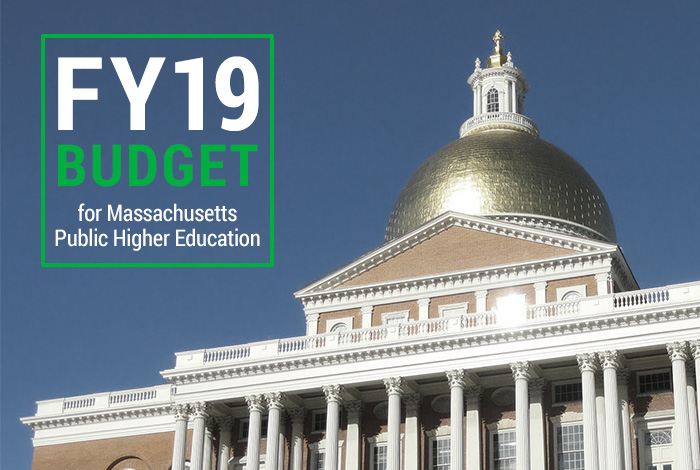
Carlos E. Santiago, Commissioner of Higher Education, testified before the Joint Committee on Ways & Means on March 19, 2018, in support of Governor Baker’s FY2019 budget request

Thank you for the invitation to testify today. I truly appreciate the opportunity to talk with you about achieving our common goals for Massachusetts’ system of public higher education. Our priority objectives for the state’s public colleges and universities are best characterized by what we call “The Big Three”:
This is the framework for my remarks today on our FY19 budget request. My team and I, along with campus leaders, look forward to working with you and your colleagues in the House and Senate to build a thriving, cohesive, and sustainable system of public higher education in the Commonwealth that can deliver on these shared objectives.
I am very much aware of the ongoing fiscal challenges faced by the Ways and Means committees each year as you work to build a balanced budget that supports a myriad of public purposes with limited resources. I see similar challenges faced by our campus leaders as they continue to seek creative and thoughtful ways to innovate and adapt in a rapidly changing landscape.
Despite the challenges, we must work collaboratively to address two disturbing trends that threaten our state’s ability to compete in the global marketplace:
Both of these trends – an enrollment decline colliding with a retirement boom – are challenges that public higher education is uniquely positioned to address. The Commonwealth’s public higher education campuses educate more than half of the state’s undergraduates – including more than 70% of Latino and African American undergraduates. The vast majority of our students – nine of every ten, to be exact – remain in Massachusetts a year after they graduate. The public campuses are poised to play an increasingly vital role in educating the state’s future workforce. To do so successfully will require us to help more students succeed in less time – and at a cost that won’t leave them so saddled in debt that they are can’t afford to buy a home or pursue a graduate degree.
This work lies at the heart of our public mission, which is to serve the public good by investing in the state’s human capital. It is our job to make sure that every Massachusetts resident who is willing to work hard, regardless of economic status or cultural background, has the means to attain a college degree – which remains the “Gateway to the American Dream.” Investments in public higher education change lives and, in doing so, they change communities. Research shows a strong correlation between higher educational attainments and positive social, economic, and health outcomes. Given that public higher education graduates are far more likely than graduates from private institutions to remain in Massachusetts and contribute to our economy and to our communities, this correlation produces a highly desirable rate of return. The bottom line is that when our students succeed, so does our Commonwealth.
With that economic framework in place, I now would like to turn to the Board of Higher Education’s top priorities for the coming fiscal year as reflected in the Governor’s House 2 budget proposal.
Without a doubt, the centerpiece of the FY19 higher education budget proposal is the $7.2M increase in financial aid funding included in the House 2 Budget. As the Governor highlighted in his state of the Commonwealth address, these funds would double the amount of need-based aid currently administered by the Department of Higher Education for degree-seeking community college students who file a FAFSA and have remaining unmet financial need for tuition and fees after accounting for all other state and federal grant aid and expected family contribution.
Nearly 4,500 students are expected to qualify for this aid at an average cost of just under $1,600 per student. I am particularly pleased that this proposed aid will be extended for the first time to part-time students. Certainly this investment will go a long way toward addressing the most crucial problem faced by college-going students today – how will I afford my college education? According to a recent study of Massachusetts’ financial aid system, the median unmet need for full-time, full-year students in Massachusetts is just over $11,000. We see this proposal as a critical step in a broader affordability strategy that builds upon existing pathways toward associate and baccalaureate degree attainment.
Complementing this historic investment in student financial aid is an additional $250,000 to help offset the costs currently borne by campuses for grants to students who participate in the Commonwealth Commitment program. This signature initiative, available through our redesigned MassTransfer system, helps shave thousands of dollars off the cost of a college degree by awarding financial incentives to students who begin their studies at a community college and then transfer to complete their program at a state university or UMass campus.
In addition, the House 2 budget includes full funding for the Foster Care Adopted Tuition and Fee Waiver and the Foster Care Grant programs. These two financial aid programs were created many years ago to help families afford the post-secondary education costs for children and youth involved with the Department of Children and Families (DCF). This important investment complements the ongoing work by the DCF to strengthen our child welfare system and create ladders of opportunity for the young people in their care.
Lastly, regarding our access and affordability initiatives, I wish to echo the Secretary’s comments about the Early College program and the $3 million in new funding to support higher education pathways that begin at the high school level. These funds will support high-quality early college partnerships that foster connections between community school districts and our public colleges. Our experience has shown that these partnerships are instrumental in helping thousands of students, especially those who are underrepresented or first-generation students, to create for themselves viable pathways to college completion and career success.
This line item is one of the most essential tools available to DHE to incentivize the public campuses to meet statewide goals and to scale best and promising practices across the public higher education system. This competitively-awarded grant program allows individual campuses and campus consortia to pursue innovative strategies to implement proven practices that support student success. PIF dollars are expandinguse of open educational resources, online course offerings, competency based education, and accelerated degree completion. PIF dollars have also provided crucial support to campuses to improve transfer advising and expand support services to students. Without this financial support we would not have been able to create a seamless transfer system from two to four-year public institutions.
The PIF fund is also our main mechanism for encouraging campus work to close achievement gaps and increase college completion. Let me share some examples of how we’re using PIF funds, and where we’re seeing results:
The PIF program has allowed educators to become innovators. We are now seeing pilot programs with proven results being brought to scale in communities across the state. I urge your continued support for the Performance Incentive Fund program, a highly effective resource which has produced, and will continue to produce, a substantial return on investment.
I would like to highlight a couple of new funding commitments in the FY19 budget proposal:
The Governor’s budget restores funding for the performance-based funding formula for the community colleges and state universities. Linking additional state funding to the strategic goals of the commonwealth – including student success and workforce alignment – is critical to moving our system forward on a unified front. It is essential that as we work to refine performance-based metrics to evaluate our success at the campus and the system levels, we recognize the importance of making the connection between resources and outcomes, and commit ourselves to delivering optimal value to our students and to all our stakeholders.
I’d like to close as I opened my remarks today, with an acknowledgement of the difficulty of your task each year. In that spirit, the budget proposal before you seeks to align state funding with our “Big Three” goals of promoting access and affordability, addressing opportunity and achievement gaps, and improving our college completion rates. While each of the three segments of public higher education differs in terms of their purpose and their challenges, I see a system that is poised to build upon successful efforts to cooperate and collaborate and create and sustain public value. Our public institutions can accomplish much more by working together than by competing with each other. The beneficiaries of this ongoing work will be the students, their communities, and by extension, the Commonwealth and its future.
I welcome any questions that you may have, and appreciate the opportunity to present this testimony.
Thank you.
This testimony was delivered at the Joint Committee on Ways & Means hearing held March 19, 2018, at the Wiggin Auditorium, Peabody City Hall, 24 Lowell Street, Peabody, as part of a series of public hearings held throughout February and March focused on different components of Governor Baker’s FY2019 budget request.
The Legislature will release their budget proposals, with the House Ways & Means version expected in mid-April and the Senate Ways & Means version expected in mid-May.